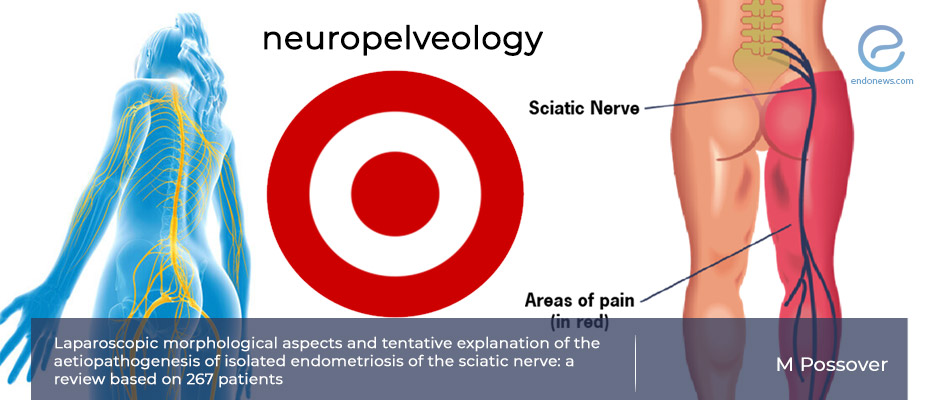A rare but important disease: "isolated" endometriosis of the sciatic nerve
Feb 23, 2022
Experience on 267 cases of "isolated" endometriosis of the sciatic nerve diagnosed by laparoscopy and biopsy
Key Points
Highlights:
- Endometriosis of the sciatic nerve is an important and debilitating clinical entity: cyclical sciatic nerve pain in women may be a clue to potential endometriosis of the sciatic nerve.
- This type of involvement may be isolated, only endometriosis existing in the particular patient.
- The hypothesis of the surgeon experienced in this rare entity is that solitary endometriosis of the sciatic nerve originates from the stem (pluripotent) cells and begins with the development of isolated endometriomas within the nerve manifesting as cyclic pain without neurological disorders.
Importance:
- Revealing the detailed features of "isolated" endometriosis of the sciatic nerve may well permit the development of more precise means of prevention and therapy of this rare but important entity.
What's done here:
- Two hundred sixty-seven consecutive patients with solitary (isolated) endometriosis of the sciatic nerve confirmed at surgical laparoscopic investigations at a single institution having special expertise on “neuropelveology” were presented in this retrospective study.
Key results:
- A single-center having expertise in the diagnosis and treatment of injuries and dysfunctions of the pelvic nerves, ie. “neuropelveology” has operated on 452 patients with endometriosis of the sciatic nerve in a time span of 16 years.
- Among these 267 patients were found to have "isolated" endometriosis of the sciatic nerve not being affected by extension from a parametric, ovarian, or other intraperitoneal deeply infiltrating endometriosis.
Limitations of the study:
- Although this series of patients yielded valuable information on "isolated" endometriosis of the sciatic nerve, a better understanding of this enigmatic entity could be possible with multicenter collaborative studies.
Lay Summary
Professor Marc Possover from Zurich, Switzerland has published his 16-year experience of surgical laparoscopic interventions on isolated endometriosis of the sciatic nerve in a recent issue of the official publication of the European Society for Gynecological Endoscopy; Facts, Views & Vision in ObGyn.
Endometriosis is a problematic disease, both for the patients and physicians but endometriosis of the sciatic nerve (ESN) is even more enigmatic. Cyclical sciatic nerve pain in women may be a clue to potential endometriosis of the sciatic nerve and should be investigated in this regard.
All consecutive 452 patients who underwent laparoscopic surgery in a 16 year period for ESN (with biopsied histopathologic confirmation) at a single center with expertise in the diagnosis and treatment of injuries and dysfunctions of the pelvic nerves, ie. “neuropelveology”.
Among these 267 patients were found to have "isolated" ESN not being affected by extension from a parametric, ovarian, or other intraperitoneal deeply infiltrating endometriosis. Patients were classified into three groups according to the time interval between the onset of sciatic pain and the time of surgery: less than 1 year (Group 1, n=67), between 1 and 3 years (Group 2, n=83), and more than 3 years (Group 3, n=117).
In Group 1, 76% of the patients had cyclical sciatic nerve pain, without sensory or motor disorders of the lower limbs. Laparoscopy revealed mainly an isolated endometrioma in the nerve itself, the size is proportional to the time elapsed since the onset of pain. In Group 2, the pain had become constant in 91% of the patients with neurological disorders of the lower extremity, like foot drop, muscle atrophy in about 30% of patients. Laparoscopy showed intraneural cystic lesions and retroperitoneal fibrosis in more than 80% of the patients. In Group3, more than 80% presented with neurological disorders of the lower limb, and all patients showed massive retroperitoneal fibrosis with endometriomas in the nerve and adjacent pelvic wall muscles at laparoscopy.
"Isolated" endometriosis of the sciatic nerve seems to be one single disease at different stages of its development, starting first with the development of an endometrioma within the sciatic nerve, then evolving into a perineural fibrosis era expanding into the whole retroperitoneal space and then may well affect surrounding anatomical structures. This is a very unique disease since it yields a different peculiar aspect on the pathogenesis of endometriosis. A possible hypothesis could be the development of endometriosis of the nerve from progenitor pluripotent stem cells present within the nerve, that could mutate and proliferate to cause endometriosis locally.
Research Source: https://pubmed.ncbi.nlm.nih.gov/35026098/
endometrisosis sciatica sciatic nerve neuropelveology
DISCLAIMER
EndoNews highlights the latest peer-reviewed scientific research and medical literature that focuses on endometriosis. We are unbiased in our summaries of recently-published endometriosis research. EndoNews does not provide medical advice or opinions on the best form of treatment. We highly stress the importance of not using EndoNews as a substitute for seeking an experienced physician.<< Previous Article
![To be or not to be [surgery or hormonal therapies for pain] that’s the question!](/member_files/size/94x94/object_files/endonews.com/2022/02/22/surgery.jpg)
